Clean up your cells! The Best Protection Against Aging, Cancer, Alzheimer's disease & Co: 5. Autophagy vs. mTOR: How can I optimally balance my life with the laws of biochemistry?
Now we finally arrived at the destination. The grand finale is coming up. Who should win for you? mTOR (represented by the ghosts) or the autophagy (represented by your cellular packman)?
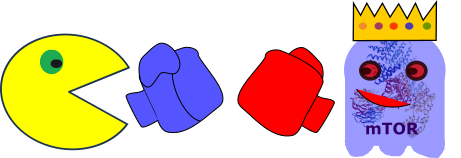
In recent articles, we have learned more about the mechanism of autophagy is and figured out which role mTOR has. For better understanding, I depicted the whole setting as some kind of packman game. By doing this we assumed that the most important thing in life is to trigger packman (the autophagy) constantly, by subsequently suppressing mTOR and his friends (“The Ghosts”). Translated into the language of metabolism, of course, this would mean again: no sugar, no milk, permanent fasting. In short: Doing things we don’t like, the entire time. But no worry! I’m not a food fetishist and I won’t preaches to you for the thousandth time what the right way of living is. No, I would like to approach it a bit more diplomatically this time, because one thing must be clear: Every extreme idea might eventually become destructive. But what is the “right thing” to do? In fact, these big questions, which millions of people are dealing with and filling an uncountable number of magazines and diet guides each week are not easy to answer. And the reason is quite simple: Your body is unique and complex, thus you cannot be treated arbitrarily. Therefore, all that I can offer (and no one should offer you more), is to share information with you about metabolism and how nutrients are fitting in the cellular biochemistry. After understanding basic concepts, you will be able to optimize the way you eat and how you shape your live. First of all, it's important to know that even though many parts of your body can be synthesized by yourself, the most building materials and energy supplies, however, must be imported from external sources. This, in turn, means, that you have to feed your body in an adequate manner to ensure a sufficient nutrient supply. Therefore, if you meet someone who tells you to avoid the intake of a certain nutrient, you should always be skeptical. But let us have a closer look at what your body is made of:
** The main components of your body **
• Proteins
• Fat
• Carbohydrates
• Coenzymes
• Ions
• Water
Ok, the last thing is quite clear. Of course, you need clear and pure water! At least your body consists about 55% to 65% water (newborn 80%)more about this here. In accordance with water, you need ions, salts & Co. But you have to be careful. To much salt is toxic and can, therefore, be harmful to you. However, I won’t go too far into detail, because this article is about autophagy and mTOR. Nevertheless, it should be mentioned that it was shown that high concentrations of salt inhibit mTOR [1]. However, it has also been shown that the effect of salt is highly dependent on the current state of the body. In the end, however, too much salt is making everything worse. Therefore, keep your hands off too salty things! Just make sure you drink enough soda & Co., flavor your food in a reasonable manner and then you'll definitely have enough salt and delicious food as well.
** Vitamins & Coenzymes **
However, especially important are the coenzymes (as well as co-substrates). Coenzymes are all possible compounds that your body can produce only to a limited extent, but which are crucial for the function of your body, as they enable, for example, the functionality of enzymes. Typical examples of coenzymes are the vitamins. Some vitamins can be produced by humans, but often in insufficient quantities (for example, vitamin D) [2]. Some vitamins, like those of the B series, are produced by other organisms and therefore have to be supplied externally. To all vegetarians and vegans: No panic! The most B vitamins are also produced by plants and yeasts (cheers!) [3]. However, the most important, namely vitamin B12, is primarily found in animal products (although even in animals it is produced by bacteria and can also be found in traces in some plants!) [4, 5]. And even if you think vitamin B12 also in little quantity is sufficient I have to disappoint you. Vitamin B12 is an essential coenzyme for the synthesis of DNA. A lack of vitamin B12 can, therefore, have tremendous consequences for you [5]. Moreover, it is not recommended to supply vitamin B12 alone. You have to know that all B vitamins are acting together in an orchestrated manner to be fully active. People who avoid the consumption of meat because of healthy or ideological reasons should, therefore, make the best use of vitamin B as a combination drug. [6]. Unilateral intake of a B-vitamin must be avoided at all costs.
But I digress far too much again. I think it is clear that avoiding certain basic nutrients should be well considered. However, before we come to the carbohydrates, I would like talk about a coenzyme, which is extremely important for the rest of the article. We are talking about adenosine triphosphate, ATP. Do you remember how kinases work? I told you in the fourth article of this series that kinases need negative-charged phosphate groups to transfer them to other proteins and to modulate their function. This phosphate residue will be connected to ADP in the power plants of the cells, the mitochondria, to generate the extremely reactive ATP [5, 7]. ATP is the cell's energy currency and its availability is the absolute prerequisite for most cellular responses. In addition, ATP is also part of the DNA. And now guess what is absolutely important for the synthesis of AMP (from which ADP and finally ATP can be formed): Of course, B vitamins and especially B9 (folic acid) and B12 (cobalamin) [8, 9]. I think you can estimate that everything is interconnected in a very defined manner. Because of this I strongly advise against any experiments. But do not worry, you do not have to eat a bunch of meat all the time (your daily need of vitamin B12 is solely just 30 μg a day, for example [5]). We will also see that the consumption of meat must be undertaken carefully.
** Carbohydrates: Is this food or can it be discarded? **
But first to the carbohydrates. Oh god carbohydrates. Satan must have invented it to ruin our well-shaped body every summer. Stay away from carbohydrates, or not? Ok, at first: carbohydrates are absolutely important to us because they are an essential part of our cells. Moreover, proteins acting outside of the cell carry carbohydrates on their surface (a so-called glycosylation) [10, 11]. But also receptors bearing little sugar trees. The sugars are a prerequisite for the correct folding of proteins. Furthermore, the sugar trees are protecting the proteins against digestion and more. Additionally, the glycosylation is an essential tool for the interaction of proteins with target molecules [12]. So if you think carbohydrates are just devil's stuff without any useful purpose, you are completely wrong. No less important, however, is the function of carbohydrates as an energy carrier. For this reason, some basics of cellular biochemistry have to be briefly discussed, namely glycolysis and the associated metabolic pathways.
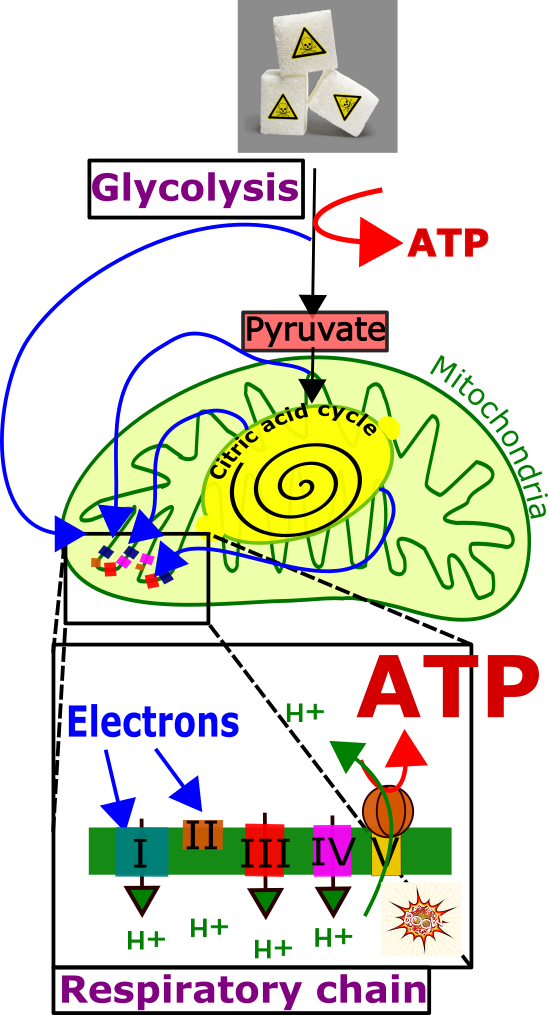
In the picture, you can see the glycolysis and the mitochondrial respiratory chain, as well as the citric acid cycle in between. Glucose is first oxidized to pyruvate during glycolysis. There are two main sources of energy, namely some ATP and reduction equivalents. We already know ATP, it's the base currency of the cell. Reduction equivalents are units that transfer electrons. The entire metabolism is always about the transfer of electrons. Every “good” nutrient has electrons and these electrons are getting extracted from the nutrients in several enzymatic steps and packed as reduction equivalents. The goal of an efficient metabolism is to extract as many electrons as possible from a nutrient. However, this is not completely carried out by glycolysis (so there are still electrons left in the pyruvate), which is why in subsequent steps (including the citric acid cycle), virtually the last remaining electron is pressed out of the nutrients. If the glucose is then completely converted into reduction equivalents, the equivalents are transferred to the mitochondrial respiratory chain. This chain (complex I to IV) can be imagined as some kind of hydroelectric power plant. The electrons, transported by the reduction equivalents, now being used to pump protons (hydrogen ions, H +). Due to this pumping mechanism, the pressure on one side of the inner mitochondrial membrane increases, leading to an explosive discharge. During this discharge, the pressure is used to pump protons back through the so-called ATP synthase (complex V), which uses the concentrated power, in turn, to attach a phosphate ion to an ADP, resulting in ATP. One molecule of glucose produces more than 90% of the ATP molecules when fully utilized in this way. Glycolysis and other processes generate the remaining 10% [5]. In principle, the cell does not need to use the mitochondria to consume glucose. The cell is, more or less, able to handle the entire energy generation via glycolysis. Nevertheless, a lot of disadvantages are connected with a diet like this. At first, anaerobic glycolysis generates a lot of acid (lactat) which affects your cells in a bad way. Further, the consumption of glucose elevates your blood sugar level in a risky way. Especially for the last argument, please also check the article by Scienceblocks here.
Now you need to know that you can compensate for problems with the glucose (acidity, blood sugar…) simply by eating fats and proteins. Fats and proteins (consisting of amino acids) generate energy primarily via the mitochondria [5]. The important thing, however, is the fact that the glucose utilization works much faster on the one hand, what your brain, among other things, very pleased. On the other hand, sugar is also the starting point of many other metabolic reactions without which it does not work. See the next picture.
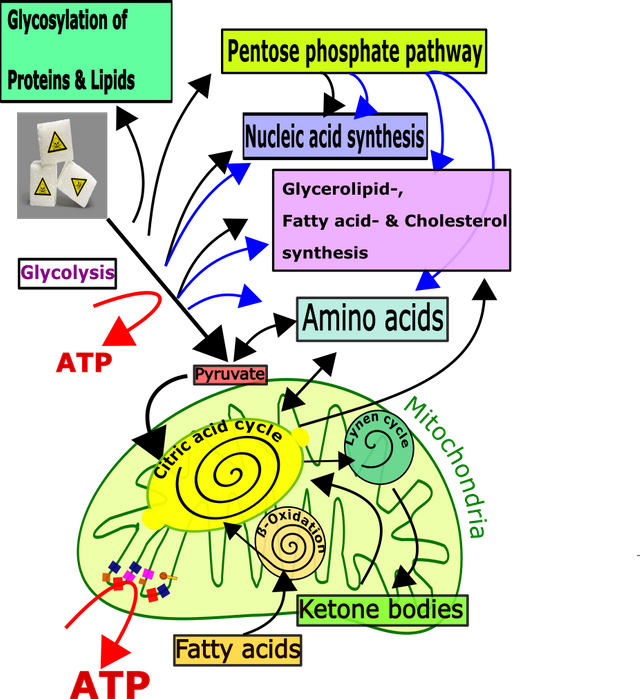
It can be seen that in the course of glycolysis (or even by glucose itself) numerous side reactions are possible. You can see blue and black arrows in the picture. The blacks arrows declare the flow of by-products (degradation products of glucose, for instance). The blue arrows, on the other hand, show the flow of the abovementioned reduction equivalents. For better understanding, we should take a closer look at the carriers of these reduction equivalents.
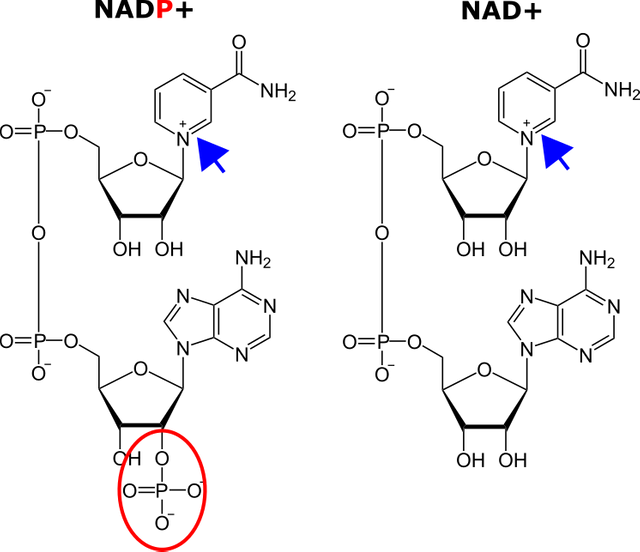
In the figure above, the two coenzymes NADP + and NAD + are shown, which are responsible for the transport of reduction equivalents (primarily electrons). NAD in its reduced form (NADH + H +) thereby delivers the electrons e.g. to the respiratory chain to realize the generation of ATP. NAD + is therefore important for energy production. NAD ** P ** H + H + (the reduced form of NADP +), however, transports electrons to important anabolic metabolic reactions, especially for the synthesis of nucleic acids (which later becomes DNA, among others), amino acids, and all the "fatty" stuff. Now one can argue that there is also an enzyme that can easily convert NADH into NADPH, the so-called NAD kinase (again, a kinase) [see] [13]. Therefore, it would require no glucose to generate NAD** P ** H, because NADH is also created in the degradation of fatty acids or amino acids. This is completely correct and would immediately put an end to the need for glucose. The key advantage of glucose is (apart from the fact that the NAD kinase, of course, needs ATP) that, in addition to the already mentioned rapid metabolism, essential intermediates are generated, without which the said anabolic pathways would simply not be realized. These substances are mainly glycerol for the synthesis of triglycerides, ribose-5-phosphate for nucleic acid synthesis, pyruvate for the synthesis of non-essential amino acids, as well as derivatives of glucose (such as mannose) which are crucial for the sugar trees on proteins and lipids, and much more [5, 12]. I think the reader understands that glucose indeed has important functions in the organism, but not in an inflationary amount as Scienceblocks has already described it. Among other things, I mentioned the problem of extreme glucose intake in the fourth article, when I described that insulin released upon glucose uptake activates the mTOR signaling pathway. Nonetheless, it can get even worse. For instance, if too much sugar remains unused in your body. In this case, in addition to the already mentioned acidification, insulin resistance, etc., so-called AGEs emerge. AGEs (Advanced Glycation End Products) are sugar derivatives which are formed non-enzymatically in the reaction of sugars with proteins, lipids and also nucleic acids (in a so-called Millard reaction) [14]. Since these AGEs are getting attached to your cells and can cause numerous damage (more about this perhaps elsewhere), they lead to stress and all the associated phenomena (for example, aging, as the name AGEs already suggests). The formation of AGEs is especially promoted upon to high sugar intake or if the removal of sugar from the blood hampers (for instance in the case of insulin resistance). Moreover, the creation of AGEs can also be promoted if you consume sugar too late in the day. The reason for this is the sleep hormone melatonin, which effectively blocks your pancreas [15, 16]. As a result, melatonin prevents the adequate release of insulin. The sugar, therefore, stays in your bloodstream longer and causes the formation of AGEs. Another problem with sugar is that glucose often does not come alone. In most desserts, soft drinks and also fruits, glucose occurs together with fructose. Although, fructose is also metabolized via glycolysis [5] and even the independence of fructose towards insulin is not that critical at a first glance [17]. The problem is rather that especially your liver absorbs the fructose and stores it as fat [18]. However, since the liver should not necessarily serve as a fat store, health problems may occur, among others the fatty liver. Furthermore, heavy accumulation of fat in the liver causes cells to be less responsive to insulin, promoting the much-cited insulin resistance, more about this subject can be found here. Incidentally, this also applies to all other areas in your body where the liver finally delivers fat. Furthermore, you must be aware that the easily digestible sugar and insulin together slow down your fat loss [5, 19]. Please take into account, that If you always have sugar in excess your body will store that. Therefore, delicacies such as French fries are a special health disaster. Anyway, we can continue to discuss this subject probably until the end of all days. Therefore, I would suggest that it is time for a brief conclusion about carbohydrates:
** Carbohydrate conclusion: **
• Sugar can certainly serve as a starting point for building materials
• Sugar can quickly provide energy to the most organs (especially the brain), so it has a positive effect on your
fitness
• In excess, sugar (especially the duet of glucose and fructose) may cause
o the acidification of the body
o stress in your pancreas
o the induction of the mTOR signaling pathway and thus the prevention of autophagy
o the formation of AGEs
o the accumulation of fat
o and in the worst case, the promotion of a fatty liver and consequently insulin resistance
**How can you consume carbohydrates in a reasonable and healthy manner? **
First, spare your pancreas and eat nutrients with branched carbohydrates, that means especially unprocessed foods. Branched carbohydrates can be found mainly in various types of vegetables but also legumes such as beans or peas. But it is also important that the vegetables are not completely cooked. The rawer, the better, because the glucose is released successively, which increases your insulin levels only moderately. As a result, you stay full longer and your mTOR activity stays on a healthy level. Further, whole grains contain a high level of branched carbohydrate. For bread fans, pumpernickel or wholemeal bread instead of toast bread (toast bread is very bad) is recommended. Also, try to consume as little fructose as possible. I recommend whole fruits, instead of fruit juices, for example. Fruit juices are concentrated sugar bombs, fruits, however, are natural and have next to sugar other (beneficial) substances (such as fiber and vitamins) [6]. In addition, you would really have to eat a lot of whole fruits to get a comparable equivalent to juice. That you should keep your fingers away from soft drinks is hopefully clear without further explanation. Otherwise, it may be important to repeat that the consumption only of little amounts of carbohydrates in the evening is absolutely necessary. Give the AGEs no chance! Taken together, carbohydrates are not necessarily the problem. The problem is an oversupply of sugar in a pathological manner.
Fat, or not fat, that is the question
If you've been able to keep track of the red thread above, then I hope you realize that no foods that may be part of your body should be avoided. As a child of the 90s, I can still remember a true fat hysteria (today it's more because of the carbohydrates). At that time it all started with these low fat or "light" products (as we say in Germany). Unfortunately, the term "light" holds only true for the products. Afterward, however, the consumers were not that "light" anymore. And even the products are not really light, because fat is a carrier for taste. Therefore, if you remove fat from certain foods you have to substitute it with something that keeps the food tasty and that's usually ... you guessed it: It is of course sugar [20]! I do not want to talk big about fats or lipids, because this article is about mTOR and autophagy. I don't want to make food advise for you. But one important fact has to be in your mind: fats or lipids are energy bombs! From one molecule of fatty acids, you can easily get three to four times more energy as from a molecule of glucose. These results are of huge importance for us because lipids deliver us a lot of energy in the shape of ATP. Much ATP in turn means high mTOR activity and this is due to another important kinase that we should discuss, namely AMPK. You'll see in the next picture how the infamous ATP looks like.
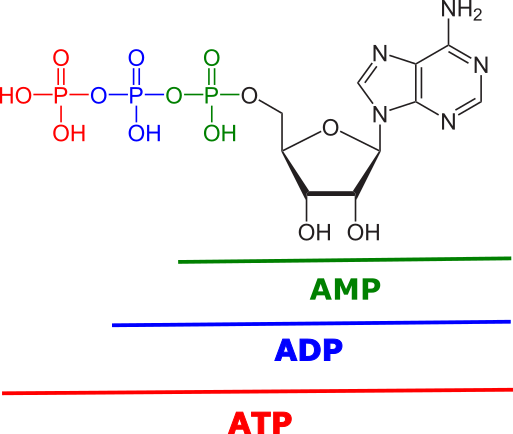
Why is ATP so reactive? I always imagine it this way: All three phosphate ions are negatively charged and therefore repel each other. The closer you get the phosphates together, the stronger is the "pressure" in the molecule. In consequence, any enzyme that can unleash the power of the "unrelaxed" phosphates will be able to release a lot of energy. I know some physical chemist will probably freak out for the explanation, but that's how I imagine, and I think it's a good analogy. ATP is, therefore, the ultimate energy carrier and this is provided in the utilization of fats in extreme abundance. However, with a high level of ATP, the enzyme AMPK has no chance to get into action. AMPK stands for an AMP-activated protein kinase because it is activated in the event of an oversupply with AMP [21]. An oversupply of AMP, however, only exists if the cell has experienced an energy minimum, for instance in the case of low nutrient supply. So, what does all this have to do with mTOR and autophagy? AMPK for its part is a supporter of the cellular Packman by acting as Ghostbuster, see the next picture.
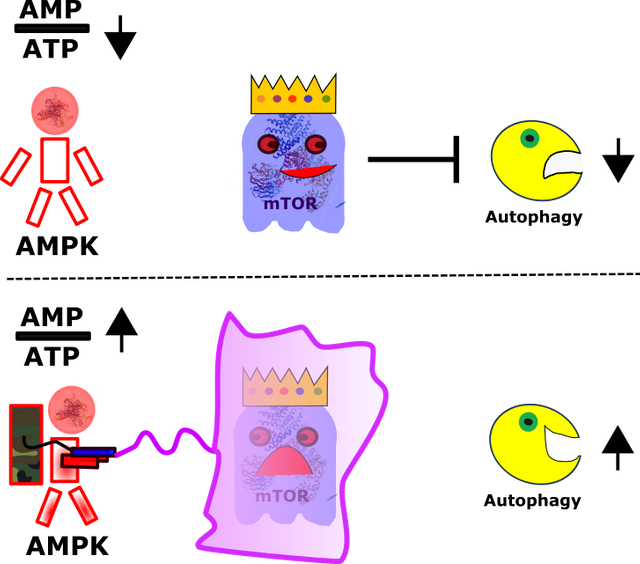
As you can see AMPK starts to act at a certain amount of AMP. Upon a critical concentration, AMPK binds AMP and finally is fully active. This, in turn, means for you that an ongoing high intake of energy carriers, which cause a high ATP content, prevent autophagy. Nevertheless, consider that lipids are very healthy. In fact, lipids are essential for your survival. Lipids are acting in various different cellular mechanisms, for instance, are lipids important signaling molecules in your brain. Moreover, without lipids, there is no brain development. Additionally, lipids are important anti-inflammatory agents [5, 22-27]. Above all, our cells consist of a significant extent of lipids. For instance, 50% of the cellular membranes are made of lipids. Another fatty molecule, cholesterol, is also of huge importance, despite his shameful reputation. It is also an eminent component of your cell membranes, as well as responsible for cellular signal transduction. Moreover, is cholesterol a key source for the synthesis of hormones and vitamins, as well as for the formation of bile acid [5, 12]. Eventually, it is the same as in the case of carbohydrates. The most important thing is simply to make sure you're consuming natural fats. That means again that you have to avoid industrially processed foods. Further, vegetable lipids are much healthier as lipids from animal products. Especially nuts, but also fatty fish or fish oil (vegetarians can also use alternatives such as algae oil capsules) or seeds are recommended [6]. In any case, avoid Margarine (trans fats) and an excessive amount of foods with saturated fatty acids (which, among other things, stiffen your cells). Incidentally, the great thing about olive oil is that it contains a high level of polyphenolic compounds which are feasible to inhibit mTOR [28]. Keep up the good olive oil.
Proteins: mTOR‘s Buddies!
So far, we talked about numerous nutrients and discovered that fats (lipids) and carbohydrates (especially glucose) activate mTOR more indirectly. In the case of lipids, for example, by decreasing AMPK activity and in the case of glucose via the insulin signaling pathway (but of course also due to the inactivation of AMPK).
[* I should perhaps say one more thing at this point: The assumption that fats or lipids do not increase the level of insulin is in my opinion incomplete. On the contrary, it seems that fats or free fatty acids have an effect on insulin levels. Since I'm not quite sure how it really is, I just referred to a few references [29-33]. If anyone knows it better, he should put a correction in the comments below. Many Thanks.*]
For proteins, the whole thing is, in my opinion, is a bit more clear. Since a few years, the mechanism of amino acid- or protein-mediated mTOR activation is better understood. According to the current state of research, the following picture emerges: The proteins are taken up and will be digested. The released amino acids further enter the lysosomes (you remember, lysosomes are those structures that later also form our cellular packman). If the level of free amino acids exceeds a certain critical limit, various proteins ("friends of mTOR", if you want) on the surface of the lysosomes allow mTOR to bind and thus enabling the induction of the mTOR signaling pathway [34]. It is particularly interesting that animal proteins seem to activate mTOR much more than proteins from plants [35]. The exact cause is not known to my knowledge. However, it seems that above all a high proportion of essential amino acids (these are amino acids that we can not produce ourselves) in animal products is responsible [36]. One of these amino acids, methionine, is particularly critical because it is in most cases the first amino acid in proteins [5]. If your body has no methionine, you are not able to synthesize proteins and thus no cell division occurs. Therefore, depending on what you wanna do with your body, you should take into consideration which proteins fit your concept. If you are pregnant or very young, a high intake, especially of essential amino acids is recommended. Moreover, if you need to build up a lot of muscles, the consumption of proteins is absolutely important. But there are a few things you have to keep in mind. At first, you have to know that amino acids such as leucine can also cause the secretion of insulin [37]. Insulin, as we already discussed above, additionally activate the mTOR signal pathway and has a many other consequences [38]. In addition, you have the above-mentioned mTOR activation via the lysosomes. Furthermore, amino acids are also fuels thus promoting the generation of ATP. To much ATP again means low AMPK activity, and low AMPK activity again means that mTOR can act undisturbed [21]. So, if you're eating a lot of protein, there are at least three mechanisms letting mTOR freaking out:
1. Insulin signaling
2. Activation via lysosomes
3. Prevention of mTOR inactivation due to high ATP load
The latter point (point 3) is then additionally reinforced by sugar and fat. The first point is also reinforced by glucose. Additionally, if you are also slightly overweight and therefore have an increased insulin resistance, then more insulin will be released. This gives your mTOR again more extra boosts, etc., etc. etc... In short, you can do whatever you want, your cellular packman has no chance. You have to much energy substrates (sugars, fats, amino acids, perhaps even alcohol) and in addition to much cellular building material (rather than you probably need). On the top of it, you probably receive the toxic fructose in between, plus trans fats, and all these things together late of the day, which brings you some extra AGEs. I think it's completely understandable that your cells won't love it. Of course, at a young age, this cocktail may probably give you a growth boost, but at least when you are older it could get very nasty. The fact is that at a certain age (I would say it's already in your early 20s) you just do not need so much building materials anymore. Especially people who are a bit older, maybe in their 50s, live extremely dangerous with such a lifestyle. The reason is that at a certain age more and more cells tend to degenerate occasionally in the body [35]. In principle, degenerated cells die and getting recognized and removed by the immune system. Unfortunately, when mTOR runs on 200% these cells have a better chance to survive and thus may become cancer. In studies, it was shown that mice infected with tumor cells had a tremendously increased prone for the development of a real tumor upon high protein intake. In contrast, in control groups with a low protein diet, the cancer prevalence was remarkably diminished. Similar results were also observed in humans [35]. Please try to figure out how much nutrients you really need (I don't mean calorie counting!). Especially, pay attention to the composition. The fact is that your body requires a basic protein content. Proteins are building materials for your body. Therefore is your hunger staved when your protein demand is satisfied [36]. Because of this reason, it is of huge importance to consume an appropriate amount of protein, but take into account to eat
1. the „right“ proteins
2. and „pure“ proteins
This in turn brings us to the same conclusion as in the case of carbohydrates and lipids. Eat as natural as possible. At best from plants. Legumes, for example, have a significantly lower level of essential amino acids and cover your protein hunger very efficient [39]. Therefore, find your optimal "protein strategy" and be aware that both, the timing (especially concerning your age) and quality of the food, really matters.
Oops, now I just noticed that the article is getting too big. I post the rest in another article, there you will find all references, as well as the final answer to Packman and “The Ghosts” ;-)

So cool with the grapics and comics :-) nice article!
Thank you, enjoy!
Of course, it's a lot of work but I try to keep good content upright!
I don't know when the next article(s) are done.
Check out my blog occasionally!
Best
Chapper
Very good .i think your article is much informative.hope to get more...all the best
Thank you very much.
I appreciate that you like what you see.
Please feel frei to ask if something is unclear.
Regards
Chapper
Posted using Partiko Android